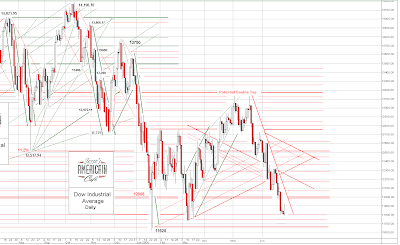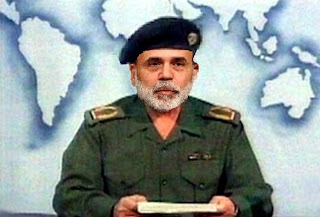 Wall Street and the financial interests painted a picture of a 'bottom' and continued to hand off the losses and risk to the public and shareholders.
Wall Street and the financial interests painted a picture of a 'bottom' and continued to hand off the losses and risk to the public and shareholders.
You were warned.
It is not over.
Goldman Cuts Banks, Strongly Advises Selling Citi
Thu Jun 26 11:32:32 2008 EDT
By Ed Welsch
NEW YORK (Dow Jones)- The business models of Wall Street investment banks and U.S.-based global banks continue to deteriorate and their recovery will take longer than anticipated, Goldman Sachs Group Inc. told clients Thursday.
The firm cut its recommendation of the sector to neutral from attractive and strongly recommended that investors sell shares of Citigroup Inc., saying it faced multiple problems, including more asset write-downs, higher loss provisions for consumer credit and the potential for more capital raises, dividend cuts or asset sales. (But they'd buy them for $2 and a backstop from Benny. - Jesse) Financial stocks declined broadly, with shares of Citigroup recently falling 6.5% to $17.62 after earlier reaching a new 52-week low of $17.57. The previous low of $17.99 was reached March 17. A Citigroup spokeswoman said the company doesn't comment on analyst reports.
Financial stocks declined broadly, with shares of Citigroup recently falling 6.5% to $17.62 after earlier reaching a new 52-week low of $17.57. The previous low of $17.99 was reached March 17. A Citigroup spokeswoman said the company doesn't comment on analyst reports.
The move came as Goldman itself was downgraded to market perform by analysts at Wachovia "in light of renewed economic fears" and a poor outlook for investment banking business. Goldman is widely considered to be the strongest investment bank in the U.S. Goldman shares fell 3.2% to $177.84 in recent trading. By adding Citigroup to its conviction sell list and expressing caution on other financial firms, Goldman reversed the positive stance it took on the financial sector following the near-collapse of Bear Stearns Cos. Wall Street had hoped that March 17 had marked the bottom for financial stocks and write-downs. Although write-downs have been slowing, more problems have cropped up for the banks as their boom-year businesses in structured financial products disappear and their assets tied to consumers deteriorate as the overall economy weakens.
By adding Citigroup to its conviction sell list and expressing caution on other financial firms, Goldman reversed the positive stance it took on the financial sector following the near-collapse of Bear Stearns Cos. Wall Street had hoped that March 17 had marked the bottom for financial stocks and write-downs. Although write-downs have been slowing, more problems have cropped up for the banks as their boom-year businesses in structured financial products disappear and their assets tied to consumers deteriorate as the overall economy weakens.
Goldman cut its second-quarter and full-year estimate for several financial firms, both large and small. The most significant cuts were on Citigroup and Merrill Lynch & Co. (MER) -Goldman now sees both firms posting losses in the second quarter and full year; it put the second-quarter losses at 75 cents a share at Citigroup and $2 a share at Merrill. Goldman also cut its estimates for Piper Jaffray Cos. (PJC), Lazard Ltd. (LAZ), Evercore Partners Inc. (EVR)and Greenhill & Co. (GHL).
Shares of Merrill fell 4.9% to $33.73 in recent trading. A Merrill spokeswoman said the firm doesn't comment on analyst research.
Goldman expects Citigroup to take $9 billion in write-downs during the second quarter and Merrill to take $4.2 billion in write-downs in the quarter. Both firms are scheduled to report their second-quarter results in mid-July. Bernstein Research also added to the gloomy chorus on investment banks Thursday, swinging its estimate of Merrill's second quarter to a loss. Bernstein expects Merrill to write down $3.5 billion during the quarter on its collateralized debt obligations, mortgage-related legacy exposures and its counterparty exposure to monoline insurers.
Bernstein Research also added to the gloomy chorus on investment banks Thursday, swinging its estimate of Merrill's second quarter to a loss. Bernstein expects Merrill to write down $3.5 billion during the quarter on its collateralized debt obligations, mortgage-related legacy exposures and its counterparty exposure to monoline insurers.
Bernstein said its projection of a second-quarter loss of 93 cents a share could prove to be too optimistic, "given the uncertainty of where CDO marks and monoline reserve levels will be this quarter."
Citigroup Chief Financial Officer Gary Crittenden said the bank would take "substantial additional marks on our subprime exposure" if current trends continue. He said the second quarter remained challenging but "was characterized in many respects by sequential improvement" over the first quarter, when Citigroup posted a loss of $5 billion on more than $10 billion in write-downs.
"However, the market continues to change rapidly, and volatility remains unprecedented," he said. "This could cause the remainder of the quarter to shape up very differently from what I've just discussed."
The analysts said the most troubled business units of the financial firms are investment banking, where merger and acquisition activity has slowed and where underwriting remains depressed compared to year-earlier levels, and the distressed areas of the fixed-income market made up of mortgage-backed securities.









































